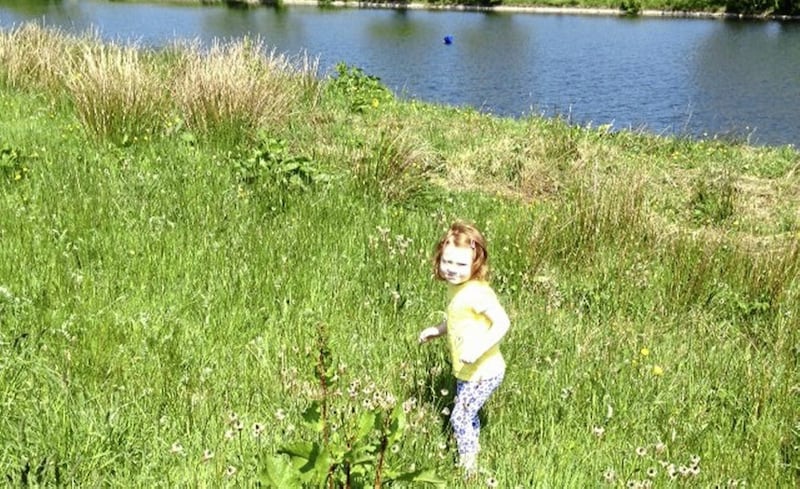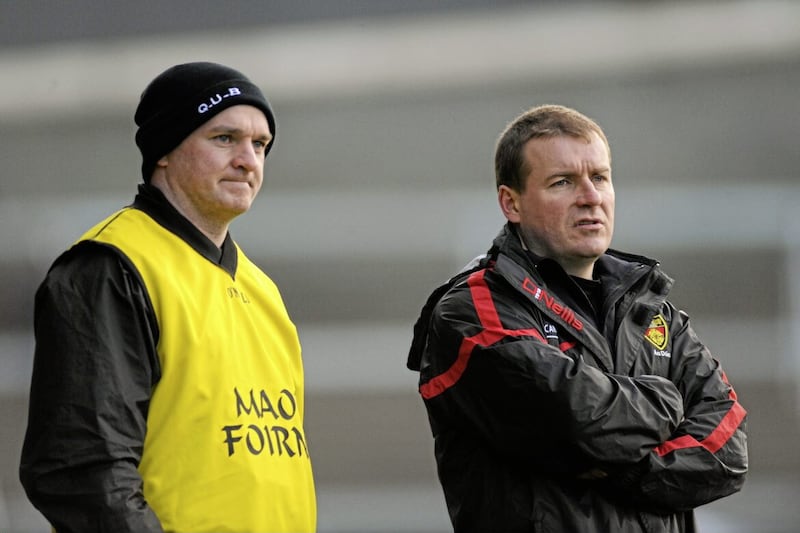ONE sunny afternoon in the summer, I decided to revisit my roots with my three-year-old daughter Rosa.
Ligoniel, situated on the outer reaches of north Belfast, was an idyllic place to grow up. Surrounded by sprawling fields, hills and dams, it was a kid’s paradise, especially in summer-time.
The old Wolfhill housing estate consisted of two streets and two cul de sacs. Now, it’s virtually unrecognisable as new houses have sprouted up everywhere, eating into the green fields where we once played football from dawn ’til dusk.
The three dams are still there. The diggers couldn’t build houses on them. During the industrialisation of Belfast, the dams helped power the local linen mills.
By the time the Crossan clan settled in north Belfast’s quiet hinterland in the early 70s, the old mills had long shut down. When we were kids, all that remained of the old factory mills were rusted steel stanchions, small orange brick huts with tiny windows and damp concrete floors, and a million discarded spools of old linen that lay strewn across what was once a thriving factory floor.
I thought it was a romantic idea for my daughter and I to catch butterflies above one of the dams. Just below the grassy bank of the main dam was one of two pitches where we used to play football.
It was known as the three-a-side pitch (now covered by houses); the other, beside another dam close by, was known as the five-a-side pitch. They weren’t real football pitches, of course. They were glorified fields turned into relatively flat areas by the constant stomping of young feet.
Both pitches hosted some epic battles between friends. Often, adults joined in the games. Matches would last for hours. It was on these bumpy surfaces where every kid in the estate learned the game. It was where skills were honed; where touch and technique were beaten into shape. In those games, we learned to improvise, we learned about space, when to pass, when to dribble. These rickety old football pitches taught us game intelligence.
There was no such thing as floodlit 4G surfaces, or fancy Predator boots, jazzy tracksuits or ubiquitous centres of excellence recruiting and then coaching out of us all the great things we’d learned on those fields. Things like spontaneity, problem-solving, dribbling. A lot of modern coaching stifles imagination and makes clones out of every kid who feels blessed to pass through the doors of these much-vaunted centres of excellence.
We wandered over to the other place where we played football. The grass is now knee-high. Standing roughly in the middle of the old ‘five-a-side’, it was impossible to figure out the dimensions of the old pitch.
There probably hasn’t been a football match on it in 20 years or more. Despite it being a beautiful sunny day, there wasn’t one kid playing in the street or the nearby fields. There was an eerie feeling to the old place.
But of course, these are different times, the PlayStation era, where kids – eyes glued to screens – only leave their bedrooms when they have to.
There is no such thing as a spontaneous football match breaking out in summertime because everyone is indoors. And if they’re not holed up indoors, the kids are whisked off to the nearest soccer academy where individualism is crushed and you’re taught not to dribble, not to take risks and not to be so off-the-cuff.
In 2010, I interviewed Peter Canavan for a chapter in a book called Voices of Croke Park. Due to a major club-county dispute that manifested in Tyrone in the 1980s, the precocious Canavan was denied the chance to play competitive football at county minor level for a time because his club was banned by the Tyrone County Board.
As a teenager, Canavan honed his skills in a field known locally as ‘the Holm’: “The fact that I wasn’t being thrust into competitive situations was giving me the opportunity to practise,” he explained.

“The development of my left foot was primarily down to that fact. I would have practised at ‘The Holm’ kicking points over the bar on my own. There was a big grassy bank directly behind the goals, so I had my own Hill 16. If a shot went to one side of the goals in particular the ball could end up in the river.
“So I would kick the ball from 30 yards and chase after it before it reached the river. Without that, I might not have got the opportunity to develop the skills in the way that I did.
“Looking back,” he added, “one of the benefits of the dispute was that I wasn’t playing the same amount of games as others.
“Burn-out was never going to be a factor and I had more time for practice. If you look at what’s happening now to talented U14 or U16s, they’re out every other night training. They don’t even get to train with their clubs because they’re with development squads, their county teams, and if their schools are successful, they’re going to be heavily involved there.
“I didn’t have that at an early age, which meant I had a stronger appetite for the game by the time I was 18, 19 and 20 years of age. And because I didn’t play as many games as a lot of other players, it probably left me more competitive.”
Nobody interpreted Gaelic football better than Peter Canavan. His imagination on a football field was one of his greatest attributes. His appreciation of space was on a different level.
One wonders what kind of player Canavan would have been had he not spent endless hours alone at ‘The Holm’, kicking balls over the bar? Indeed, what kind of player would Canavan have been had he hooked up with umpteen teams in his formative years?
For me, the genius of Peter Canavan was formed at ‘the Holm’. There are exceptions of course, but nearly every soccer or Gaelic football match looks and feels the same these days. The clever artisan is nearing extinction.
On that trip back to Ligoniel in May, we caught one butterfly. But Rosa decided to let him go because he was born to fly.








